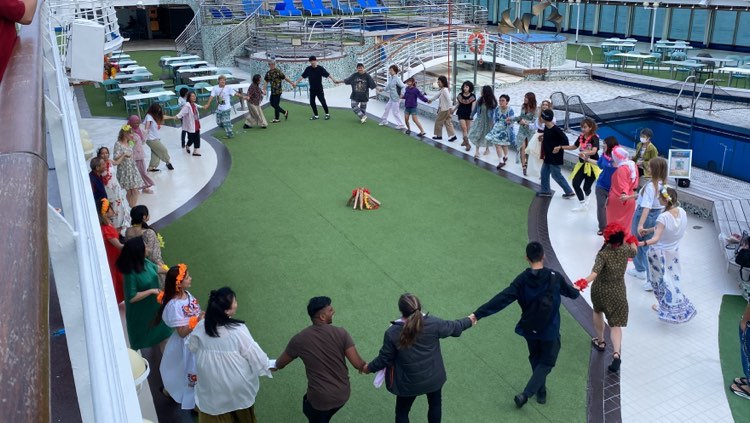
From the Ship
Ukrainian Culture on Peace Boat: Celebrations, Folk Art and Music
Onboard Peace Boat’s 117th Global Voyage, the Ukraine Youth Ambassadors (UYA) organized, along with their war testimonies, numerous workshops introducing Ukrainian culture, history, traditions, everyday life and customs. Tetiana Vazhynska initiated the celebration of the Ukrainian Easter Egg Workshop, and with other UYA explained the meaning and family traditions of this important holiday in Ukraine.

Tetiana showed various symbols that are used to decorate Easter Eggs in Ukraine: wave and grid patterns symbolize natural elements such as water, the ground, rakes, grain and lightning, which portend a rich harvest; shapes of the sun, animals and fish depict health and longevity; pictures of sunflowers, pines and leeches are drawn as healing symbols and illustrations of spruces and flowers are symbols of love. All participants created their own drawings on the eggs and talked to the UYA about Ukrainian customs during festive days.
Yuliia Chekhovska reminisced about her childhood in western Ukraine, when she used to go to church on Easter Day to sing in the choir carrying a basket full of colorful Easter Eggs.

Another event was dedicated to national clothing. Adelina Lysenko introduced the embroidered traditional Ukrainian clothing called Vyshyvanka. All of the seven UYA appeared on stage dressed in multicolored vyshyvankas, some white with red embroideries and others black with yellow decorative embroideries.
“The name vyshyvanka comes from the Ukrainian word vyshyvaty, which means ‘to embroider’”, explained Adelina. “When making real vyshyvankas, the thread used to embroider them is dyed naturally using ingredients like plants and minerals. As you can see, the areas around the collar and the opening in the sleeves are embroidered, which comes from the belief that evil spirits enter from openings in the clothing, and thus these parts are embroidered to protect the wearer. Since 2006, the third Thursday of May has been celebrated every year as World Vyshyvanka Day.”
After Paris Fashion Week 2015, vyshyvankas have become popular worldwide. Now they are part of global fashion and can be found at international brands like Zara and H&M.

In addition, Adelina held a separate workshop to teach participants how to make motanka dolls, traditional Ukrainian guardian dolls that serve as family talismans.
“The name motanka comes from the Ukrainian word motaty, which means ‘to wind’. You make the doll by winding fabric without using needles,” said Adelina, demonstrating the process of wrapping several bright pieces of cloth around each other to create the doll’s head and body.

“Motankas are believed to be lucky charms that protect you and your family from misfortune. Motankas have empty faces, because, according to folkloric belief in Ukraine, it is thought that wicked spirits enter the body through our eyes, nose and mouth. Motankas are a symbol of protective and healing power in Ukrainian culture,” explained Adelina.


During the voyage, Yuliia Chekhovska, Antonina Korotenko, Tetiana Vazhynska and Adelina Lysenko held regular Ukrainian language classes. Sofiia Demydenko initiated Ukraine Karaoke Nights onboard with Ukrainian pop music and Ukraine Music Nights. In addition, UYA and CC (Communication Coordinator) Anna Karbovnycha, also from Ukraine, performed the popular Ukrainian folk song “Chervona Ruta” in front of a large audience on the ship dressed in vyshyvankas, conveying the beautiful and melodic sounds of Ukraine.

Close to the end of the voyage, the UYA organized “Ivana Kupala”, a Ukrainian summer festival, onboard the Peace Boat deck, one of the cultural highlights on the 117th voyage, led by Mariia Borzykh. Ivana Kupala is a traditional East Slavic festival dating back to pre-Christian times. In Ukraine, it is celebrated every year in the evening between 6 and 7 July.
At the start of the festivities on the ship, a dance group that had met multiple times to practice under the instruction of Mariia Borzykh, Natalia Makohon and Adelina Lysenko, all wearing beautiful flower wreaths, gave a performance with the Youth Ambassadors, dancing to the melody of Ukrainian music.

An artificial bonfire was prepared using logs and illuminations, and participants danced around it late into the night with Ukrainian folkloric and disco music playing in the background. Dancing with passion, Natalia Makohon commented with a big smile: “I feel so happy dancing to the tunes of my native land. It thrills me to watch everyone here, Ukrainians and non-Ukrainians, dancing to the music of my country.”
Ivana Kupala brought together people of diverse ages and backgrounds to join hands and celebrate traditional Ukrainian music and dance. The festival, lasting into the late hours, celebrated life and hope, expressing the mutual understanding of people of different nationalities who can overcome language and cultural differences and enjoy the universality of music, dance and humanity.


